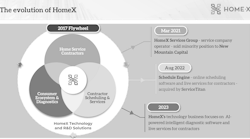Are you one of the many companies that ask this question when you get your monthly Income Statement? You are cruising along, working hard and the Income Statement shows you are making a profit. But cash flow is poor and the company may even be having problems paying bills. This is particularly true when the company is in a growth mode.
The major culprit causing the cash flow problem is a lack of Working Capital. Working Capital is the money needed to fund day-to-day operations. By definition, it is Current Assets minus Current Liabilities. Both of these are Balance Sheet accounts. As a general rule, Working Capital should be a minimum of 10% of annual sales. So as a company grows, so does its need for additional Working Capital. It’s the Net Profit that’s retained in the business that funds the Working Capital needed for growth.
Although a company may be showing a profit, it may not be enough to fund the cash needed for Working Capital. For an HVAC residential replacement and service focused business, the minimum Net Profit needs to be 10%.
DOWNLOAD AND PRINT THIS PDF: LABOR BURDEN AS AN OPERATING EXPENSE
Another situation that contributes to the problem is when the Income Statement is not structured correctly, and the owner thinks the company is more profitable than what it really is. This happens when an owner pulls his/her wages as a cash disbursement on the Balance Sheet rather than treating it as an Operating Expense on the Income Statement. The result is still the same, a lack of genuine profitability and consequent cash flow problems.
So what’s a company to do to correct the problem when profits are not sufficient to cover Working Capital needs? One answer is to compare the company’s financial performance to industry Key Performance Indicators. This process is called benchmarking. KPIs are critical performance measurements modeled after successful companies. Each business segment, department, has its own set of performance metrics. For example, here is the direct cost model for HVAC residential service.
The 64% gross margin may seem a bit high for many companies, but recognize that service department overhead typically comes in around 50% So don’t you deserve a dime to 14 cents profit for all of the work and headache of running a service department/
Benchmarking department performance does require tracking both revenue and cost of sales by department, but it’s worth it to get the information needed to manage individual department performance.
The process of benchmarking allows you to ‘ASK” why things are done the way they are and it challenges existing norms. It helps you identify opportunities to improve performance and then identify what needs to change to achieve the desired results. Perhaps it’s a pricing issue, or a productivity issue, or a labor management issue, or a material cost control issue, etc.
The next step is to set goals with your management team and then to create action plans to attain those goals. By benchmarking and setting performance expectations, you begin creating a culture of ‘accountability’ in your organization.
Of course Operating Expense (overhead) also affects Net Profit. One important concept to recognize is that most overhead expenses are ‘fixed’. For example, your rent expense is a fixed cost you pay every month regardless of company revenue. Consequently, when looking at Operating Expense as a percentage of sales, revenue affects that percentage as much as actual overhead costs. Thus the role of management is to maximize the amount of gross profit dollars generated by man-day.
This is particularly important when it comes to HVAC residential replacement. When it comes to selling lower-end product or higher labor jobs, you may well need 45% or higher gross margin percentage to generate sufficient gross profit dollars to cover the overhead and generate a profit. That’s because the equipment cost is less and the resulting markup in gross profit dollars is less. In contrast, higher-end product and low labor jobs can generate the desired gross profit dollars at a lower gross margin percentage. HVAC replacement pricing strategy is just as important as cost control and productivity in achieving desired profits.
So using Key Performance Indicators, benchmarking and incorporating sound pricing strategies will provide the Net Profit needed for safe growth.









